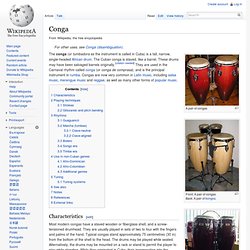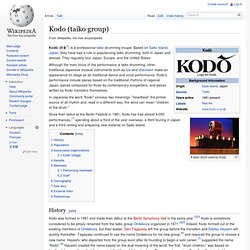

Terl Bryant - Drummer & Percussionist. Conga. A pair of congas Front: A pair of congas.

Back: A pair of bongos. Characteristics[edit] Most modern congas have a staved wooden or fiberglass shell, and a screw-tensioned drumhead. They are usually played in sets of two to four with the fingers and palms of the hand. Playing techniques[edit] Strokes[edit] There are five basic strokes: Open tone (tono abierto): played with the four fingers near the rim of the head, producing a clear resonant tone with a distinct pitch.Muffled or mute tone (tono ahogado): like the open tone, is made by striking the drum with the four fingers, but holding the fingers against the head to muffle the tone.Bass tone (tono bajo): played with the full palm on the head. Glissando and pitch bending[edit] Djembe. A djembe (/ˈdʒɛm.bɛ/ JEM-be) (also spelled djembé, jembe, jenbe, djimbe, jimbe, or dyinbe[1][2][3]) is a rope-tuned skin-covered goblet drum played with bare hands, originally from West Africa.

According to the Bamana people in Mali, the name of the djembe comes from the saying "Anke djé, anke bé" which translates to "everyone gather together in peace" and defines the drum's purpose. In the Bambara language, "djé" is the verb for "gather" and "bé" translates as "peace".[4] Traditionally, the djembe is played only by men, as are the dunun that always accompany the djembe. Conversely, other percussion instruments that are commonly played as part of an ensemble, such as the shekere (a hollowed-out gourd covered with a net of beads), karignan (a tubular bell), and kese kese (a woven basket rattle), are usually played by women. Even today, it is rare to see women play djembe or dunun in West Africa and African women express astonishment when they do see a female djembe player.[5] Bodhrán. One or two crossbars, sometimes removable, may be inside the frame, but this is increasingly rare on modern instruments.

Some professional modern bodhráns integrate mechanical tuning systems similar to those used on drums found in drum kits. It is usually with a hex key that the bodhrán skins are tightened or loosened depending on the atmospheric conditions. History[edit] According to musician Ronan Nolan, former editor of Irish Music magazine, the bodhrán evolved in the mid-20th century from the tambourine, which can be heard on some Irish music recordings dating back to the 1920s and viewed in a pre-Famine painting. Seán Ó Riada declared the bodhrán to be the native drum of the Celts, with a musical history that predated Christianity,[5] native to southwest Ireland.[6] Name[edit] Third-generation bodhrán maker Caramel Tobin suggests that the name bodhrán means "skin tray". Possible antecedents[edit] Popularity[edit] Painted Bodhrán for decoration purposes International use[edit] Drumset percussion conga djembe bongo timbales lesson drum patterns. Drumskull Drums. Drums, Percussion & unique Instruments - World Beats -
Kodo (children of the drum) A taiko drum used by Kodo Kodō (鼓童?)

Is a professional taiko drumming troupe. Based on Sado Island, Japan, they have had a role in popularizing taiko drumming, both in Japan and abroad. They regularly tour Japan, Europe, and the United States. Although the main focus of the performance is taiko drumming, other traditional Japanese musical instruments such as fue and shamisen make an appearance on stage as do traditional dance and vocal performance. In Japanese the word "Kodo" conveys two meanings: "heartbeat" the primal source of all rhythm and, read in a different way, the word can mean "children of the drum.
" Since their debut at the Berlin Festival in 1981, Kodo has had almost 4,000 performances,[1] spending about a third of the year overseas, a third touring in Japan and a third resting and preparing new material on Sado Island. The group spent the next 7 years touring Europe, Japan, North and South Americas and the Far East. Goldcoast Drums: Djembe Drums, Djembe Drum Accessories, African Musical Instruments. Official Latin Percussion Website: Play the best.